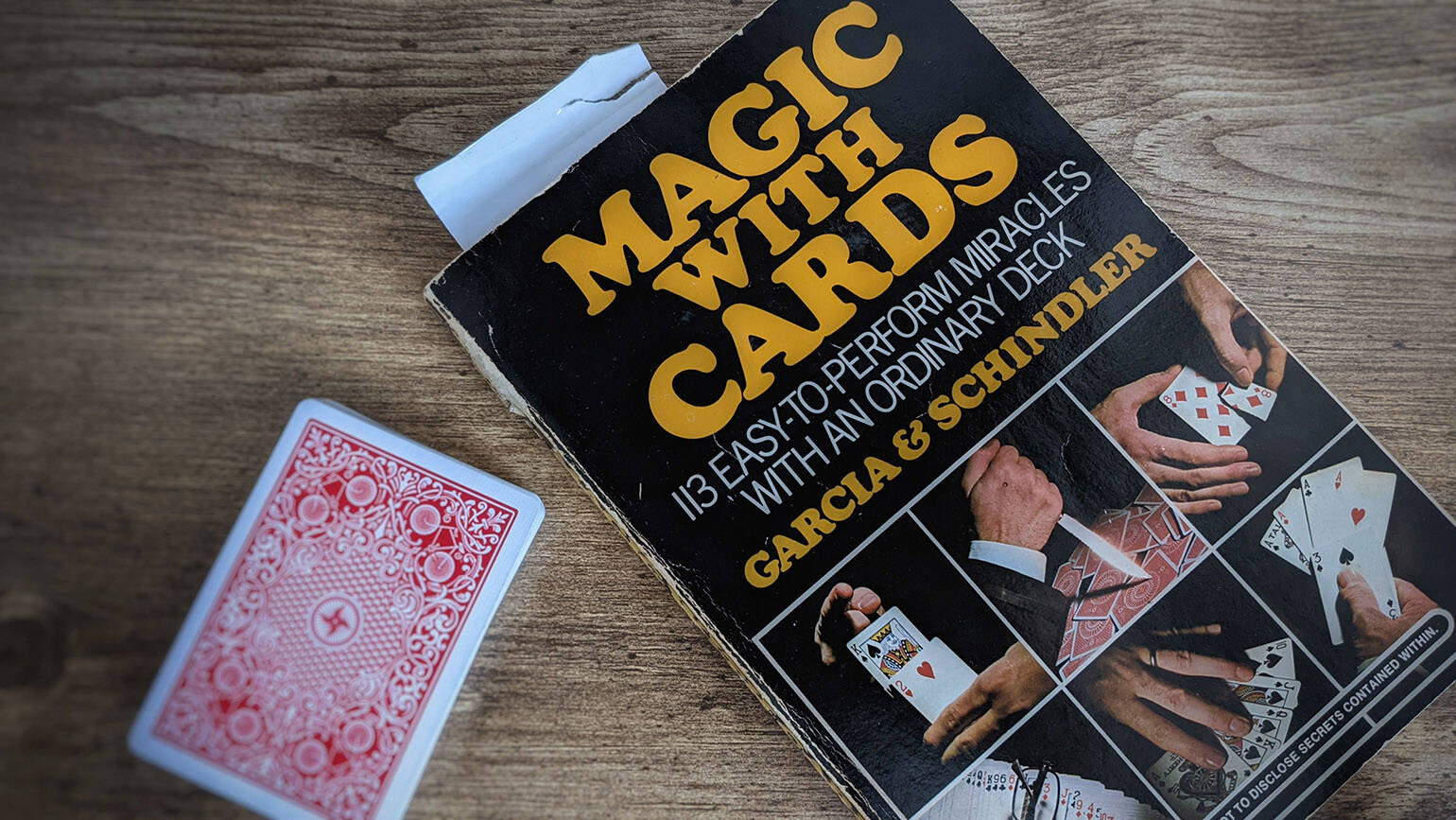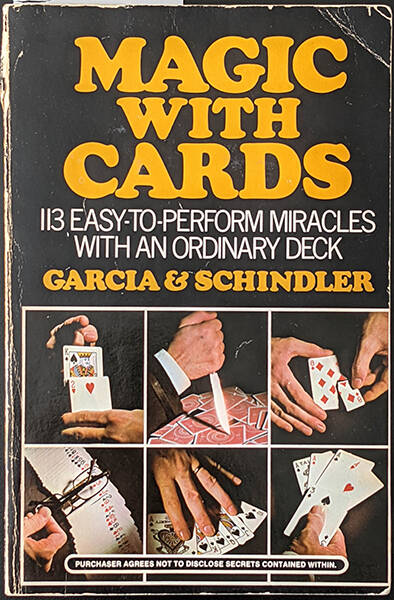

Despite the claim on the back cover of the book that Magic With Cards has the ability to turn a novice into an expert card performer, it purposefully avoids imbuing actual knowledge onto the reader and instead gets straight to the point with all 113 card tricks within it's pages. Revisiting this book, years after I originally read through it, my feelings towards it have shifted substantially but that's not to say that it's because the book itself is bad. Before diving into this topic, let's explore the background of the book a bit and we'll circle back.
The Authors
Frank Garcia and George Schindler, two magicians of the 1970's era who were friends and collaborators for decades. They wrote this book together to provide an easy entry for beginners into the field of magic. Walk-around and street magic, with cards, that is.
Garcia has several publications to his name and by the looks of it he was a well-rounded magician with works ranging from cards to sponge balls, cups and balls and billiard balls. Or, perhaps he just works with a lot of cards and balls. His nickname happened to be "The Man with the Million Dollar Hands," likely obtained via his focus on gambling and cheating routines -- though, story is that he was also a professional gambler so maybe his work crossed over to his hobby and vice-versa.
Schindler also has published several books, a few of them co-authored with Garcia like Magic With Cards. His artistic reach has extended beyond only magic, he has also worked as a magic consultant, comedian, actor, ventriloquist and a writer. Though, I think a lot of magicians could categorize into most of those ... omitting ventriloquism of course. But, that's a discussion for a different day.
Amedeo's Continental Magic and Super Subtle Card Miracles sound like books I would have, but at the time of writing I don't. In fact, I only know of Garcia and Schindler from Magic with Books. Schindler's consultation skills and contributions to the Society of American Magicians, and both of their work founding The School for Magicians, really makes me curious as to what interested them in writing a book like this one.
Foreword, or Preface?
Getting into semantics about the book's layout, Magic With Cards starts with a Foreword section that's written by Garcia and Schindler. Historically, and I would rather say traditionally, authors do not write their book's foreword -- that privilege goes to someone else. In the magic community, if a book contains a foreword we typically see a more well-known author or member of the community provide the words. This helps bring credibility to the book's author(s) if they're unknown, or gives praise from a friend to a friend. It can also help with background information too. Magic With Cards' foreword helped with background for sure, but in my opinion it killed it's own credibility with the following:
Most of the card tricks you see have been developed over the years by ourselves and other members of the magical fraternity whose devotion to the art is deep and passionate. The origins of the principles are, for the most part, unknown.
My opinion on this excerpt was actually positive the first time I read through the book. "It's great," I thought, "this book has tricks from a lot of different people so there will be a great mix and I'll learn so much!" And, that's true. There are a variety of tricks in the book and they're definitely from a lot of different people. Unfortunately, that's as specific as it gets. No credit is given to any other magician. Often, the original name of the routine is omitted and a generic one is included instead Even different sleights are glossed over, almost in an attempt to prevent the reader from being able to research further.
They do urge us, the readers, to research further though. As they describe it, "the professional magicians you see on the stage and on television all do their locations with 'hand magic'." Sleight-of-hand was never sold so well!
The preface foreword does end with them thanking the magicians that they're using principles and effects from, though as mentioned above none of them are actually named. After a few years of diving deeper and deeper into the world of magic, this just leaves a sour taste in the mouth. It makes me all the more happier for newer things like To Your Credit by Harapan Ong.
Routines, Miracles, and Card Handling
Magic With Cards contains a decent number of routines given the size of the book. As far as I'm aware, the "113 miracles with cards" also includes the topics of Spreading a Deck of Cards and The Overhand Shuffle - but even excluding these basic card handling moves leaves close to 100 different routines. And wow do they cover a lot.
The book starts with key-card style routines but doesn't really go into depth about peeks or glimpses. Rather, we get information such as "the bottom card is your key" and a fun "turn your back after [the spectator] has taken his card ... [and] secretly look at the bottom card of your pack." I laughed out loud when I read this (my second time through the book). After practicing many sleights for years now, one of the last things I would ever do, personally, is to hold the deck in my hands and turn my back on the spectator. As a beginner in magic though, or someone that this fits well with their personality or routine yeah, I could see it working though. I would have really, really loved to seen more information about different ways to glimpse the card though. Or honestly just a reference or two.
But in all seriousness, I don't know if I've ever seen such a large collection of key card based material in a single book before. There are 20 unique routines using the key card principle, and these are just the first few pages of the book. If the authors wanted to, they could have easily published a full volume with these 20 routines if they had only explored the theory more and took an in-depth look into ways to get a key card. Now's probably also a good time to say that within these few pages, they do explore things like blindfolds and even edge marking (edge marking, in a introductory magic book - nice!).
They jump through classic spelling routines, tricks with Aces and other Poker Tricks, and my assessment is that most routines are semi-self-working (as long as you get the patter right). The patter provided is fairly rough though - it's short and blunt, but it does get the message across and to the point. My recommendation with it is to only use it as a reference, or a starting point rather, and adopt it to your own style.
The chapter on Mentalism is actually pretty neat, specifically because of the use of a confederate (i.e. a partner helping you out). I don't do much in terms of mentalism - I have a few other books but at the current time I haven't read any of them, so I don't know if this is a commonly known thing. However, other card magic books that I have very rarely include the use of a partner. But seeing a picture of a "confederate's foot tapping yours to tip you to the selected card," I can't help but to get excited.
Oh, so, remember up above when I said that they don't give credit throughout the book? That was slightly a fib - they have two full chapters dedicated to stacks, the primary one being Si Stebbins. They actually use it's name, and credit Mr. Stebbins (and even provide a 1-line bio!). The detail included in the Si Stebbins Master System section is pretty great - for a beginner or even an advanced card handler, there's stuff to use here.
Takeaways
To rehash what I've tried expressing above, when I was a beginner and I first read through this book, it was amazing. The routines in it are extremely easy to follow along with and it covers so many areas within card magic that I was able to find out what I liked and what I didn't. After experiencing a lot of other books, Magic With Cards is like Royal Road meets Card College -- just a different writing style.
The routines in this book aren't advanced, but there are some strong ones included in here. If you are looking for a small (in size) book with a variety of routines - this is a good resource. If you're looking for a guide that gives overview of sleight of hand, theory, or a deep-dive into specific topics then you're better off looking elsewhere.
